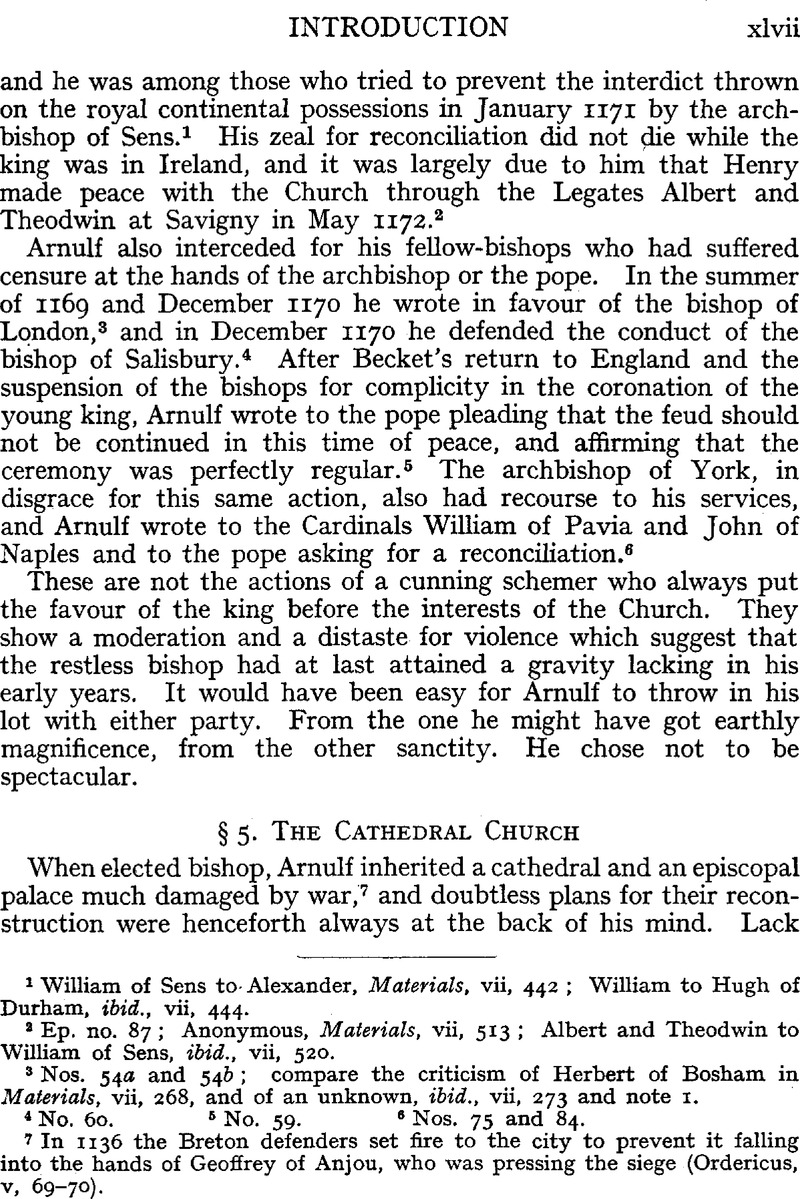No CrossRef data available.
Article contents
§5. The Cathedral Church
Published online by Cambridge University Press: 24 December 2009
Abstract

- Type
- Introduction
- Information
- Copyright
- Copyright © Royal Historical Society 1939
References
page xlvii note 7 In 1136 the Breton defenders set fire to the city to prevent it falling into the hands of Geoffrey of Anjou, who was pressing the siege (Ordericus, v, 69–70).
page xlviii note 1 He turned to repairs immediately; see below, pp. 3–4. The marriage between Henry of Normandy and Eleanor of Aquitaine, however, was not celebrated at Lisieux in 1152 as M. Louis Serbat believes (Lisieux, Petites monographies des grands édifices de la France, Paris, 1926Google Scholar). It took place at Poitiers. See the chronicle of the Counts of Poitou in H.F., xii, 410Google Scholar, and cf. the chronicle of Tours in H.F., xii, 474, and Gervase, i, 149.
page xlviii note 2 There has been considerable difficulty over fixing the date of the building of the present church, because, although archaeological evidence favoured the late twelfth century, early investigators could not reconcile the literary evidence with this. They thought that Arnulf was shown to have started building in 1143. See, for instance, C. Vasseur, ‘Études Historiques et archéologiques sur la cathédrale de Lisieux’ in Bull. Soc. des Antiquaires de Normandie, vol. x (1881). G. Huard, in an excellent monograph (‘La Cathédrale de Lisieux aux xie et xiie siècles’, Études Lexoviennes, vol. ii, 1919), reinterpreted the literary evidence, and showed that there was no conflict. Serbat, op. cit., incorporated his results in a more comprehensive but less detailed treatise, and he gives a good bibliography on p. 124 seq. It is unfortunate that all these archaeologists misdate some of Arnulf's letters, but actually this does not invalidate the conclusions of Huard and Serbat.
page xlviii note 3 Huard, , op. cit., p. 13Google Scholar, connects Arnulf's choice of French architects for his cathedral with his building operations at St. Victor, Paris. But it is unlikely that he was actually planning his retirement in detail so early, especially at a time when he had so much on hand at home.
page xlviii note 4 See below, p. 88.
page xlviii note 5 Ep. no. 63.
page xlviii note 6 By a miracle St. Thomas saved the life of a man who was entombed in a trench during the renovation of the cathedral (William of Canterbury, ‘Miracles of St. Thomas’, Materials, i, 265–7Google Scholar). Thus major foundations were being excavated after 1170.
page xlix note 1 See below, p. 209.
page xlix note 2 Huard, , op. cit., pp. 16–17Google Scholar; Serbat, , op. cit.Google Scholar
page xlix note 3 Torigni, , p. 298Google Scholar; see below, p. 209. It appears to have been finished by 1178 (see below, p. 192).
page xlix note 4 Ep. no. 63.
page xlix note 5 See below, p. lviii.
page xlix note 6 Huard, , op. cit., p. 16.Google Scholar
page xlix note 7 Vasseur, op. cit.; H. de Formeville, ‘Notice sur les Chanoines de l'Ancienne Cathédrale de Lisieux’, in Mémoires lus à la Sorbonne (1866), p. 492.Google Scholar
page xlix note 8 See below, p. 190.
page xlix note 9 See below, p. lviii.
page l note 1 Compte-rendu du Congrés Archéologique de 1844, p. 252.Google Scholar
page l note 2 See below, pp. lv, seqq.
page l note 3 De Formeville, , op. cit., p. 479.Google Scholar




